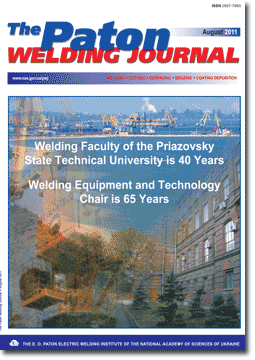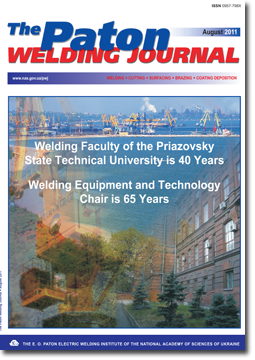| 2011 №08 (09) | 2011 №08 (11) |

The Paton Welding Journal, 2011, #8, 37-41 pages
CONDITIONS OF PROPAGATION OF THE SHS REACTION FRONT IN NANOLAYERED FOILS IN CONTACT WITH HEAT-CONDUCTING MATERIAL
T.V. ZAPOROZHETS1, A.M. GUSAK1 and A.I. USTINOV2
1B. Khmelnitsky National University, Cherkassy, Ukraine
2E.O. Paton Electric Welding Institute, NASU, Kiev, Ukraine
Abstract
The problem of propagation of the gas-free combustion (SHS reaction) front in nanolayered foils in thermal contact with the mating surfaces is considered. It is shown that dependence of the rate of propagation of the combustion front on the intensity of heat removal is of a threshold nature: there are critical values of the intensity of heat removal at which the combustion conditions in the nanolayered foil-heat-conducting material system are suppressed.
Keywords: welding and brazing, multilayer foils, heat-conducting materials, mating surfaces, self-propagating high-temperature synthesis reaction, heat removal, threshold thickness, analytical estimation
Received: ??.??.??
Published: 28.08.11
References
1. (2003) Concept of development of SHS as a field of scientific-technical progress. Ed. by A.G. Merzhanov. Chernogolovka: Territoriya.
2. Barzykin, V.V., Merzhanov, A.G., Strunina, A.G. (1990) Ignition of heterogeneous systems containing condensed reaction products. In: Proc. of 23rd Int. Symp. on Combustion. Pittsburgh: Combustion Institute, 1725-1731.
3. Ustinov, A.I., Falchenko, Yu.V., Ishchenko, A.Ya. et al. (2008) Diffusion welding of .-TiAl alloys through nanolayered foil of Ti/Al system. Intermetallics, 16, 1043.
4. Mann, B., Gavens, A.J., Reiss, M.E. et al. (1997) Modeling and characterizing the propagation velocity of exothermic reactions in multilayer foils. J. Appl. Phys., 82(3), 1178-1188.
5. Zaporozhets, T.V., Gusak, A.M., Ustinov, A.I. (2010) Modeling of stationary condition of SHS reaction in nanolayered materials (phenomenological model). Pt 1: One-stage reaction. Sovremen. Elektrometallurgiya, 1, 40-46.
6. Zaporozhets, T.V., Gusak, A.M., Ustinov, A.I. (2010) SHS reactions in nanosized multilayers Д analytic model versus numeric model. Intern. J. Self Propagating High Temperature Synthesis, 19(4), 227-236.
7. Zaporozhets, T.V. (2010) Modeling of stationary condition of SHS reaction in nanolayered materials (phenomenological model). Pt 2. Two-stage reaction. Visnyk ChGU, 171, 16-30.
8. Barron, S.C., Knepper, R., Walker, N. et al. (2011) Characterization of self-propagating reactions in Ni/Zr multilayer foils using reaction heats, velocities and temperature-time profiles. J. Appl. Phys., 109, 13-19.
9. Wang, J., Besnoin, E., Duckham, A. et al. (2004) Joining of stainless steel specimens with nanostructured Al/Ni foils. Ibid., 95(1), 248.
10. Wang, J., Besnoin, E., Knio, O.M. et al. (2005) Effects of physical properties of components on reactive nanolayer joining. Ibid., 97(11), 114-307.
11. Grigoryan, A.E., Elistratov, N.G., Kovalev, D.Yu. et al. (2001) Autowave propagation of exothermic reactions in thin multilayer foils of Ti-Al system. Doklady RAN, 381(3), 368-372.
Suggested Citation
T.V. ZAPOROZHETS1, A.M. GUSAK1 and A.I. USTINOV2 (2011) CONDITIONS OF PROPAGATION OF THE SHS REACTION FRONT IN NANOLAYERED FOILS IN CONTACT WITH HEAT-CONDUCTING MATERIAL. The Paton Welding J., 08, 37-41.The cost of subscription/purchase order journals or individual articles
| Journal/Currency | Annual Set | 1 issue printed |
1 issue |
one article |
| TPWJ/USD | 384 $ | 32 $ | 26 $ | 13 $ |
| TPWJ/EUR | 348 € | 29 € | 24 € | 12 € |
| TPWJ/UAH | 7200 UAH | 600 UAH | 600 UAH | 280 UAH |
| AS/UAH | 1800 UAH | 300 UAH | 300 UAH | 150 UAH |
| AS/USD | 192 $ | 32 $ | 26 $ | 13 $ |
| AS/EUR | 180 € | 30 € | 25 € | 12 € |
| SEM/UAH | 1200 UAH | 300 UAH | 300 UAH | 150 UAH |
| SEM/USD | 128 $ | 32 $ | 26 $ | 13 $ |
| SEM/EUR | 120 € | 30 € | 25 € | 12 € |
| TDNK/UAH | 1200 UAH | 300 UAH | 300 UAH | 150 UAH |
| TDNK/USD | 128 $ | 32 $ | 26 $ | 13 $ |
| TDNK/EUR | 120 € | 30 € | 25 € | 15 € |
AS = «Automatic Welding» - 6 issues per year;
TPWJ = «PATON WELDING JOURNAL» - 12 issues per year;
SEM = «Electrometallurgy Today» - 4 issues per year;
TDNK = «Technical Diagnostics and Non-Destructive Testing» - 4 issues per year.


